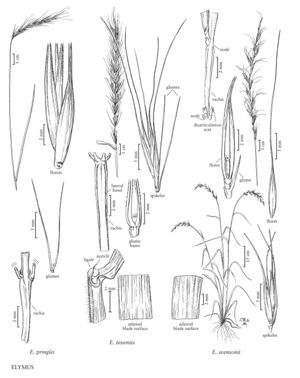Difference between revisions of "Elymus pringlei"
FNA>Volume Importer |
imported>Volume Importer |
||
| (3 intermediate revisions by 2 users not shown) | |||
| Line 37: | Line 37: | ||
|publication year= | |publication year= | ||
|special status= | |special status= | ||
| − | |source xml=https:// | + | |source xml=https://bitbucket.org/aafc-mbb/fna-data-curation/src/200273ad09963decb8fc72550212de541d86569d/coarse_grained_fna_xml/V24/V24_439.xml |
|subfamily=Poaceae subfam. Pooideae | |subfamily=Poaceae subfam. Pooideae | ||
|tribe=Poaceae tribe Triticeae | |tribe=Poaceae tribe Triticeae | ||
Latest revision as of 16:23, 11 May 2021
Plants cespitose, not rhizomatous, usually somewhat glaucous. Culms 50-110 cm, erect or somewhat geniculate at the base; nodes 6-9, mostly exposed, glabrous. Leaves evenly distributed; sheaths usually glabrous, occasionally pilose, hairs somewhat retrorse; auricles about 1 mm, pale or brownish; ligules about 1 mm, erase; blades 3-12 mm wide, lax, adaxial surfaces sparsely scabridulous, sometimes hispidulous to pilose on the veins, usually glaucous. Spikes 4-12 cm long, 2-3 cm wide, erect, the bases sometimes sheathed, with 2 spikelets per node; internodes 3-6 mm, about 0.2 mm thick at the thinnest sections, with 2 hispid dorsal angles, without green lateral bands. Spikelets 10-15 mm excluding the awns, 18-30 mm including the awns, appressed, with 3-5(6) florets, lowest florets functional; disarticulation above the glumes, beneath each floret. Glumes subequal, 12-22 mm long including the undifferentiated awns, 0.2-0.3(0.6) mm wide, setaceous, entire, 0-1(2)-veined, tapering from the base, glabrous, margins firm, awns more or less straight; lemmas 8-10 mm, usually scabrous-hispid or thinly strigose, at least distally, awns 8-22 mm, straight or flexuous; paleas 7-8 mm, obtuse, often emarginate; anthers 2.5-4 mm. Anthesis May to June. 2n = unknown.
Discussion
Elymus pringlei grows on moist slopes and canyons, in pine and deciduous tree woods, at 1500-2300 m in the Sierra Madre Orientale of eastern Mexico. This poorly known species is similar to E. texensis (see next) and E. interruptus (p. 306). It is included here because it seems likely that it also grows in southern Texas, having been collected in Coahuila, Mexico, 54 miles from the border, near Big Bend National Park (Campbell 2002).
Selected References
None.
